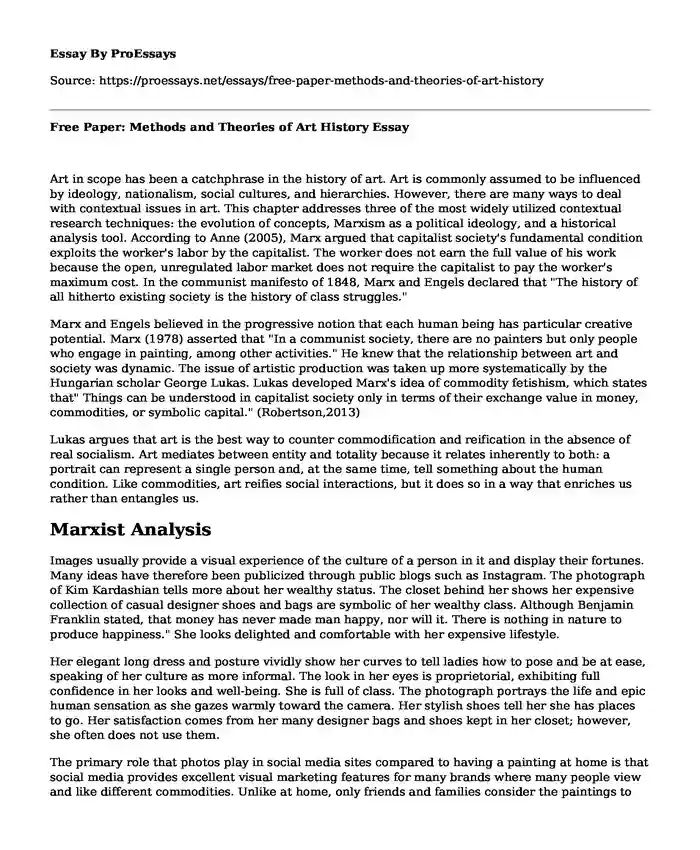Art in scope has been a catchphrase in the history of art. Art is commonly assumed to be influenced by ideology, nationalism, social cultures, and hierarchies. However, there are many ways to deal with contextual issues in art. This chapter addresses three of the most widely utilized contextual research techniques: the evolution of concepts, Marxism as a political ideology, and a historical analysis tool. According to Anne (2005), Marx argued that capitalist society's fundamental condition exploits the worker's labor by the capitalist. The worker does not earn the full value of his work because the open, unregulated labor market does not require the capitalist to pay the worker's maximum cost. In the communist manifesto of 1848, Marx and Engels declared that "The history of all hitherto existing society is the history of class struggles."
Marx and Engels believed in the progressive notion that each human being has particular creative potential. Marx (1978) asserted that "In a communist society, there are no painters but only people who engage in painting, among other activities." He knew that the relationship between art and society was dynamic. The issue of artistic production was taken up more systematically by the Hungarian scholar George Lukas. Lukas developed Marx's idea of commodity fetishism, which states that" Things can be understood in capitalist society only in terms of their exchange value in money, commodities, or symbolic capital." (Robertson,2013)
Lukas argues that art is the best way to counter commodification and reification in the absence of real socialism. Art mediates between entity and totality because it relates inherently to both: a portrait can represent a single person and, at the same time, tell something about the human condition. Like commodities, art reifies social interactions, but it does so in a way that enriches us rather than entangles us.
Marxist Analysis
Images usually provide a visual experience of the culture of a person in it and display their fortunes. Many ideas have therefore been publicized through public blogs such as Instagram. The photograph of Kim Kardashian tells more about her wealthy status. The closet behind her shows her expensive collection of casual designer shoes and bags are symbolic of her wealthy class. Although Benjamin Franklin stated, that money has never made man happy, nor will it. There is nothing in nature to produce happiness." She looks delighted and comfortable with her expensive lifestyle.
Her elegant long dress and posture vividly show her curves to tell ladies how to pose and be at ease, speaking of her culture as more informal. The look in her eyes is proprietorial, exhibiting full confidence in her looks and well-being. She is full of class. The photograph portrays the life and epic human sensation as she gazes warmly toward the camera. Her stylish shoes tell her she has places to go. Her satisfaction comes from her many designer bags and shoes kept in her closet; however, she often does not use them.
The primary role that photos play in social media sites compared to having a painting at home is that social media provides excellent visual marketing features for many brands where many people view and like different commodities. Unlike at home, only friends and families consider the paintings to give no monetary value to the owner. Through Instagram photos, one targets her audience. Also, being engaged in the community online helps one see what people talk about. By following popular hashtags, one can see popular hashtags and see what people are talking about, their concerns and problems, and their happy moments and daily victories.
Conclusion
In conclusion, art is the product of complex social, political, and economic relationships. The grounding of political and historical theories is a guide to answering the metaphysical questions raised in the community regarding methods and art history ideas.
References
Alleva, A. (2005). Methods and theories of art history. Laurence King Publishing.
Jackson, R. (2013). The subjectivity problem in Marxism: Karl Marx, George Lukacs, and Antonio Gramsci (Doctoral dissertation, King's College London (University of London)).
Stoneman, A. (2015). The New Conspicuous Consumption.
Tucker, R. C. (Ed.). (, 1978). The Marx-Engels Reader.
Cite this page
Free Paper: Methods and Theories of Art History. (2023, Dec 18). Retrieved from https://proessays.net/essays/free-paper-methods-and-theories-of-art-history
If you are the original author of this essay and no longer wish to have it published on the ProEssays website, please click below to request its removal:
- Micro Language Policy for a Hotel Essay
- Ethics in Heathcare Essay Example
- The Rosa Parks Story Movie Analysis Essay
- Paper Example on Nostalgic Fishing Vacation on a Sunny Day
- Essay on Ennio Morricone's Final Performance: 90-Year-Old Musician Retires in London
- Overpopulation in India: Challenges, Government Strategies, and Cultural Impacts - Paper Example
- Smoking Habits Among the Youth - Essay Example







